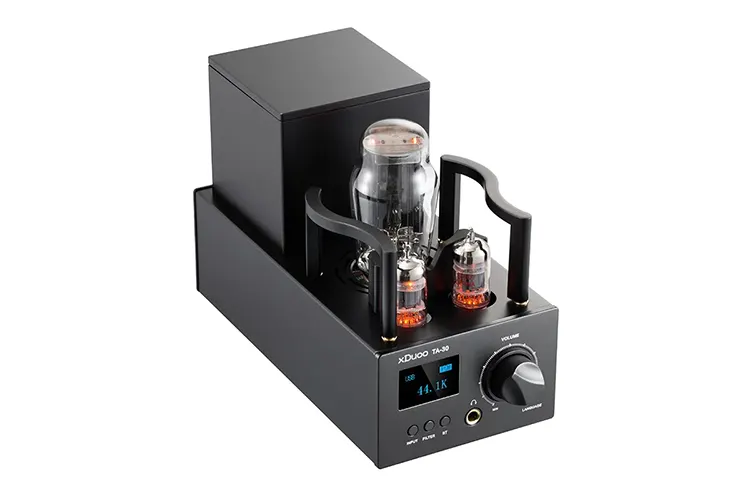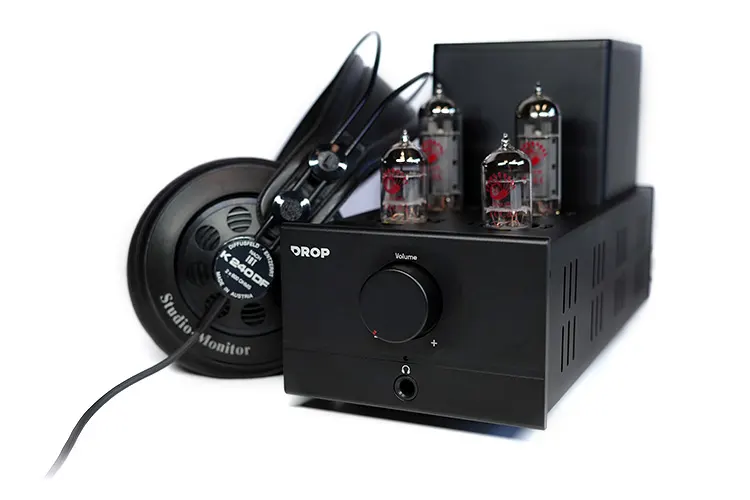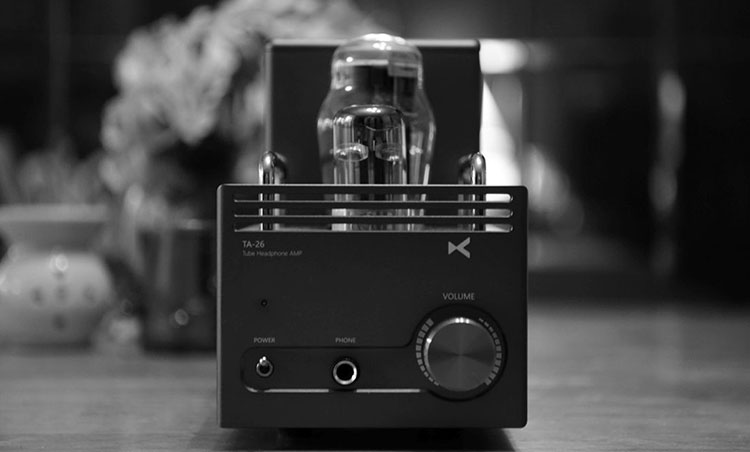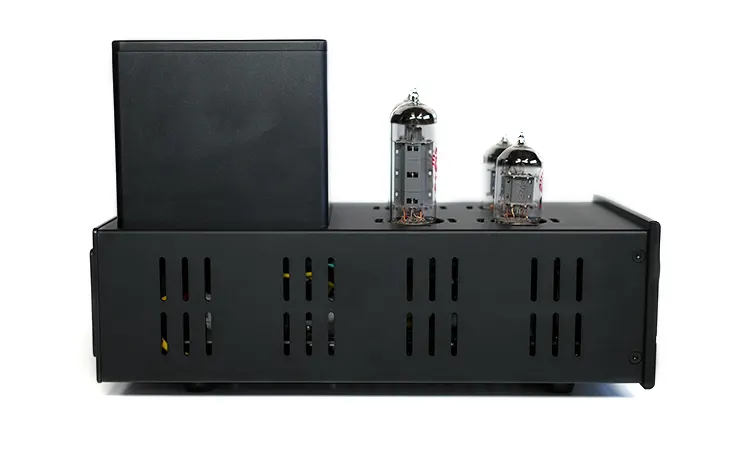Synergy
Power
The TA-84 has a rated output power of 44 mW (at 100Ω), 83 mW (at 300Ω), and 93 mW (at 600Ω). The unit is meant to drive those headphones in our collection that need more juice. It is not recommended for IEMs or planar magnetic headphones.
You should have no problem driving headphones up to 600Ω, such as the AKG240DF. If I wanted to gripe, I did have to raise the volume past 2 pm to get a really loud volume. But that was only for short periods to see if the xDuoo could handle that effort. It could.
Middle-of-the-road 300Ω headphones had no problem being driven to exceedingly loud volumes. I did note that when the volume is raised all the way, significant distortion comes about. Even one notch less quelled that distortion.
Pairings
Massdrop x Sennheiser HD 6XX
The TA-84 was provided with a pair of the Drop x Sennheiser HD 6xx for use. The venerable “standard” plays nicely with the TA-84.
There is a bit of grain to the mids when used together, but the pairing does bring out the highlights of the 6xx tuning. Mids did sound vibrant and warm, with good detail, but are pushed up and further forward. The lifting gives good height to the stage without completely taking over the signature.
Treble notes come across as smooth due to the tube pairing, and bass provides a more authoritative punch.
A solid-state amplifier would provide a tighter bass, with better control, but the TA-84 gives you a good grunt with a smooth character, which may be lacking with other sources.
Instruments in the upper mid-range can become tedious, but I now understand the appeal of the HD 6xx. For the price, these are very, very good headphones.
AKG K240 DF
There is only so much a mid-fi amplifier can provide, but the pairing with the AKG K240 DF was especially sweet. I was never left wanting more power. There is a reason the AKG K240 series was used across the globe in studios, and the pairing here does justice to that usage.
Harder to drive than any other headphone tested here, this was a testament to the TA-84’s ability to punch above the “specs” and find out what it really could do. Even at ½ volume, the AKG K240 DF sounded fabulous. There was plenty of headroom to drive it even further, but I saw no need.
For a reference-sounding signature from the AKG, the TA-84 provided a richness, which was a bit lacking to me before. The mids came across as sweeter, but without losing their grip on detail. Bass loosened a bit, but kept control, with the longer decay.
Treble reach to me is better than the HD6xx, and the slight warmth added made for a smoothing of what could have been too much sparkle. This is a very good pairing.
Of all the pairings, besides the Eikon, the AKG was my favorite with the TA-84.
ZMF Eikon
The Eikon is the only closed-back tested with the TA-84, but that did not diminish the very good signature. Clarity on par with the HD6xx, and a spacious stage highlighted this pairing.
The tubes warmed what some find as an overly clinical sound. ZMF headphones are tuned differently than mainstream, but the pairing brings out some of the best characteristics in the Eikon.
The TA-84 added weight to the notes, making for a smoother signature, which I appreciated. The detail was not lost, either. The spaciousness in note separation of the Eikon makes for a smooth melding with the TA-84.
The TA-84 seemed to rein in some of the ZMF mixed-review tuning. I appreciated that a mid-fi amplifier worked in concert with a (then) flagship closed-back headphone to provide me with a vibrant, warmer signature.

FiiO FT3
The FT3 was the easiest to drive of the headphones tested. Michael was very impressed with the headphones, and I can understand why.
The TA-84 pushed the upper mids a little higher, giving excellent height to the stage, but without losing note weight. Tubes can do that but the pairing came across with very good detail, combining with the richness of character a tube amplifier can exude. I rarely went past 1000 on the volume wheel as a result.
Excellent percussion response showed the FT3 can provide very good detail for a budget-priced headphone. I did wish for a bit more bass, and the TA-84 helped pull the notes, extending the decay enough for added weight in the sub-bass region.
Edifier R1280T Speakers
The TA-84 did not pair as well with the R1280T as I had hoped. I attribute this to the modestly powered speaker itself.
When hooked to the YULONG Aquila III though as a pre-amplifier, the Edifiers worked well. I was able to get good volume from the pairing of just the TA-84 and R1280T, but the sound was richer and warmer when used with the Aquila III.
If you were going this route ensure your powered speakers have enough of a power amplifier to compensate for the less powerful TA-84. That said, the pairing worked adequately enough that I could enjoy a full college football game using my MBP as a source.
Select Comparisons
xDuoo TA-26
Technical
Running a single 6N8P tube family for the pre-out and a single 6N5P for the primary amp circuit, the TA-26 could be thought of as ½ a TA-84. But there is more.
The tubes provided for each alone show a separation in performance. Providing sub-$10 tubes versus $40-50 tubes will do that. Suitable for headphones from 60-600Ω helps make the TA-26 a worthy candidate for your harder-to-drive units.
Design
Modeled in industrial gray, the TA-26 can cut an imposing figure on your desktop, much like the TA-84. The silver rails protecting the tubes give the unit a “CEO’s view” visual as one might find in an industrial factory of days gone by.
I like the xDuoo look, and the gray is a nice change from the all-black of the other two mentioned here.
Size-wise it is all but identical to the TA-84, so placing either is a wash. The single tubes for in and out make it look like a lighthouse calling ships home but left me wanting a bit more in the looks comparatively.
Performance
The TA-26 is indeed more powerful than the TA-84, but I found the differences were negligible when the volume was turned up.
The stock tubes in the TA-26 provided a grittier, grainy sound, which might be identified as classic-tube-like in character, but the TA-26 will benefit from better tubes.
Where the TA-26 might shout, due to the increased power, the TA-84 provided contextual cues instead. Better spatial placing was had across the board in the TA-84, even if it could not get “as loud.”
For an entry-level tube amplifier, with the capability to change tubes easily, the TA-26 is a good alternative, but to me, the TA-84 comes across as the better overall unit. Even with the limitation of not being able to use IEMs or planar headphones.

xDuoo TA-30
Technical
The TA-30 was xDuoo’s first foray into the big leagues of tube amplifiers and demanded a comparable price of $719. It followed the earlier successful TA models, setting itself as the flagship.
The TA-30 was also my introduction to the company, having reviewed the unit for my blog. Two words (mentioned already) come to mind when I think about the TA-30: “insanely powerful.”
With dual 12au7 pre-amplifier tubes and a single 5u4g tube rectifier, the TA-30 could put out a whopping 3W at 32Ω, and 2W at 150Ω.
Using a “sub-flagship level” DAC chipset in the ESS9038Q2M ESS does not hinder its use across the board. With digital and analog inputs and outputs as well as Qualcomm’s Bluetooth, the TA-30 is a do-all amplifier that deserves a place in the tube HOF, in my estimation.
Tube rolling is a must in the TA-30, and the tube rectifier is used to convert AC to DC, keeping the conversion out of the noise and amplification paths.
Design
The TA-30 set the tone for xDuoo’s premium amplifiers, and it plays that part. Larger than the TA-84, with the imposing rectifier tube showing its rightful place at the top. This is an imposing unit, with the black rails adding to the look as well.
With inputs for USB, Coax, and optical in the digital realm as well as Bluetooth and Aux-in RCA cables, the TA-30 is multi-dimensional.
Outputs include only a 6.35mm headphone jack, but the unit may also be used as an external DAC or with powered speakers via the RCA aux out. Multiple filter choices can also be made using an easily accessible switch on the front.
Performance
The power alone might be worth the entry into the TA-30. I was never left needing more power with any of the headphones I used, including the Eikon and 600Ω AKG K240 DF.
I was lucky enough to receive a care package of after-market tubes from a fellow reviewer, and upon his recommendation, I played with the choices until I found a combination I liked best. Settling on a mix of Sylvania and RCA, I found the sound enticing, which made the unit complete.
The stock tubes, much like the TA-26 sounded grainy, and did not do the unit justice. Here is where the PSVane’s stock tubes in the TA-84 do justice to the unit.
While the sound was brighter than the TA-84, the after-market tubes made for a smoother signature, which tamed that sparkly character nicely. I also found that changing tubes added detail to the signature over the stock tubes, helping to justify its higher price.
Due to the extreme power of the TA-30, I do not recommend using any IEM with it. This is a beast best left to your hard-to-drive headphones, and usage with powered speakers. This unit sets the tone for xDuoo’s following units and deserves a worthy place on your desktop.
Our Verdict
The Drop + xDuoo TA-84 is a solid answer for those of us who have high-impedance headphones and welcome a dedicated OTL amplifier with good power management at an affordable price. I found there was adequate power no matter what I threw at it.
The 600Ω AKG K240 DF sounded fabulous with plenty of warmth to the signature, countering the normally reference-like signature.
More expensive options such as the ZMF Eikon benefitted from a dedicated high-impedance option, too. The openness with which the Eikon presents a signature cozied up to the tube sound without bother, adding warmth where I needed it.
Other options such as the powered Edifier R1280T suffered from a lack of power, but that could be countered with more powerful speakers, or run the TA-84 as a pre-amplifier.
There are just enough options on the TA-84 to make for a worthy look as a viable option. I liked the power, sound, and simplicity; and can recommend it as a result.
This is a fine OTL amplifier, which could be made even better if you choose to tube roll, which is always fun. The TA-84 will take its place next to the TA-30 on my desktop as a nice addition.
Drop x xDuoo TA-84 Technical Specifications
General
- Inputs: RCA, USB-C
- Headphone Outputs: 6.3 mm TRS (¼”)
- Preamplifier Output: RCA
- Dimensions: 10.6 x 6.4 x 4.6 in (26.8 x 16.3 x 11.6 cm)
- Weight: 6.6 lbs. (3 kg)
Amplifier
- Power Source: AC 110V (100-120V) / 220V (220-240V), selectable
- Power amplifier tube: (2) EL-84
- Preamplifier tube: (2) ECC-82
- Gain switch: +16 dB
- Output Power: 44 mW (at 100Ω), 83 mW (at 300Ω), 93 mW (at 600Ω)
- Frequency response range: 10 Hz – 80 kHz (± 0.5 dB)
- Crosstalk: 65 dB
- SNR: 102 dB
- THD+N: ≤1%
- Recommended headphone impedance: 100Ω – 600Ω (amp is not well suited for planar magnetic headphones and low impedance headphones due to OTL topology)
DAC Section:
- DAC Chip: ES9018K2M
- Sampling rate: PCM 16-bit – 32-bit / 44.1 kHz – 384 kHz, DSD64 – DSD256
- THD+ N: 0.002% (at 1khz)
- S/N: 113 dB
- Crosstalk: 88 dB
- Compatible operating systems: Windows, Linux, Mac OS X, IOS, Android







